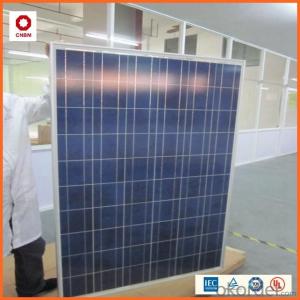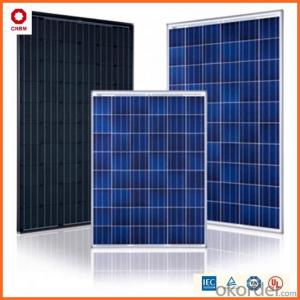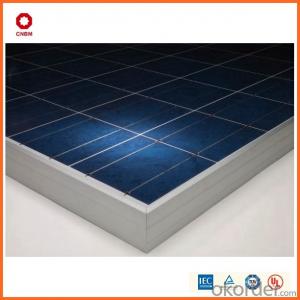40w Small Solar Panels with Good Quality
- Loading Port:
- China main port
- Payment Terms:
- TT OR LC
- Min Order Qty:
- 1 watt
- Supply Capability:
- 10000000 watt/month
OKorder Service Pledge
OKorder Financial Service
You Might Also Like
Item specifice
Hot Sale !!! Quality and Safety of Small Poly Solar Panel 25~85w
1. Rigorous quality control meets the highest international standards.
2. High-transmissivity low-iron tempered glass, strong aluminium frame.
3. Using UV-resistant silicon.
4. IS09001/14001/CE/TUV/UL
Warranties of Small Poly Solar Panel 25~85w
1. 10 years limited product warranty
2. 15 years at 90% of the minimal rated power output
3. 25 years at 80% of the minimal rated power output
Specification
Characteristics of Poly solar panels CNBM (25-85W) | |||||
Max Power Voltage Vmp(V) | 30.3 | 30.8 | 31.1 | 31.4 | 31.85 |
Max Power Current Imp(A) | 7.60 | 7.64 | 7.73 | 7.81 | 7.85 |
Open Circuit Voltage Voc(V) | 36.1 | 36.6 | 37 | 37.3 | 37.68 |
Short Circuit Current Isc(A) | 8.50 | 8.55 | 8.65 | 8.75 | 8.85 |
Max Power Pm(W) | 230W | 235W | 240W | 245W | 250W |
Temperature Coefficient of Cells Poly solar panels CNBM (25-85W) | |
NOCT | 45± 2 |
Temperature Coeffucients of Isc | 0.0492 |
Temperature Coeffucients of Voc | -0.3374 |
Temperature Coeffucients of Voc | -0.4677 |
Mechanical Data of Poly solar panels CNBM (25-85W) | |
Dimension | 1638 × 982 × 40 mm |
Weight | 19.5 kg |
No. of Cells and Connections | 60 (6 ×10) |
Tolerance | 0 ~ + 5 W |
Cell | Monocrystalline Cell 156 × 156 mm |
Packing | 624 Pcs/40ft(H) Container |
Limits of Poly solar panels CNBM (25-85W) | |
Operating Temperature | -40 to +85 |
Storage Temperature | -40 to +85 |
Max System Voltage | 1000VDC(IEC) / 600VDC(UL) |
Features of our products:
• High conversion efficiency mono/poly-crystalline amorphous silicon solar cells
• Modules incorporate high performance bypass diodes to minimize the power drop caused by shading
• High transmittance, low-iron tempered glass
• High performance EVA encapsulant to prevent destroying and water.
• AI frame: without screw, corner connection. 8 holes on the frame can be installed easily
• Good performance of preventing from atrocious weather such as wind and hails
• Certifications: CE IEC TUV VDE UL, Class I
• 10 years 90% power output warranty

Shipping of Small Poly Solar Panel 25~85w
By Sea | Delivery from Shanghai or Ningbo seaport |
By Air | Departure from Shanghai Pudong Airport |
By Express | Post by DHL, EMS, UPS, TNT. |
- Q:Are there any risks of electrical grounding issues with solar energy systems?
- Yes, there are some risks of electrical grounding issues with solar energy systems. One of the main risks is the potential for electric shock. If the grounding system in a solar energy system is not properly installed or maintained, it can lead to a build-up of electrical current in the system. This can result in a person coming into contact with a live electrical component and experiencing an electric shock. Another risk is the potential for fire. If the grounding system is not properly installed, it can cause electrical arcing, which can lead to a fire. This is particularly dangerous in solar energy systems as they are typically installed on rooftops, where a fire can quickly spread to the rest of the building. Additionally, a faulty grounding system can also lead to damage to the solar energy system itself. Without proper grounding, electrical surges and fluctuations can occur, which can damage sensitive components of the system, such as inverters or batteries. To mitigate these risks, it is crucial to ensure that the grounding system of a solar energy system is properly installed and regularly inspected and maintained. This includes using proper grounding equipment, such as grounding rods or conductors, and ensuring that all connections are secure and free from corrosion. Regular testing of the grounding system should also be conducted to ensure its effectiveness. It is recommended to hire a qualified professional to install and maintain the grounding system to minimize the risks associated with electrical grounding issues in solar energy systems.
- Q:Can a solar energy system be installed on a vehicle?
- Yes, a solar energy system can be installed on a vehicle. This is known as a solar-powered vehicle or solar car. These vehicles are designed to harness energy from the sun through solar panels mounted on the roof or other parts of the vehicle. The solar panels convert sunlight into electricity, which can be used to power the vehicle's electric motor or stored in batteries for later use. Solar cars are a sustainable and environmentally friendly alternative to traditional fuel-powered vehicles, as they reduce reliance on fossil fuels and produce zero emissions. While solar cars are still relatively new and not as widely used as traditional vehicles, advancements in technology are making them more efficient and practical for everyday use.
- Q:What permits or approvals are required for installing a solar energy system?
- The permits and approvals required for installing a solar energy system vary depending on the location and local regulations. In general, some common permits and approvals may include building permits, electrical permits, and interconnection agreements with the local utility. Additionally, certain jurisdictions may have specific requirements for setbacks, zoning, and environmental impact assessments. It is crucial to consult with local authorities and professionals to determine the exact permits and approvals needed for a solar energy system installation.
- Q:How is solar energy stored for later use?
- Various methods exist for storing solar energy for later use. One widely employed approach involves the utilization of solar batteries or energy storage systems. These batteries become charged during daylight hours, when excess solar energy is being generated. Subsequently, the stored energy can be utilized during periods of limited or no sunlight, such as nighttime or cloudy days. An alternative means of storing solar energy is through the adoption of thermal energy storage systems. These systems convert solar energy into thermal energy, which is then stored in a medium like water or molten salt. This stored thermal energy can subsequently be utilized to produce electricity or heat whenever necessary. Moreover, solar energy can be indirectly stored through the utilization of pumped hydroelectric storage. Excess solar energy is employed to pump water from a lower reservoir to a higher one. When electricity is required, the stored water is released and flows down to a lower reservoir, generating electricity via turbines. In addition, solar energy can also be stored in the form of compressed air. Excess solar energy is utilized to compress air into storage containers. When electricity is needed, the compressed air is released and expanded through turbines, generating electricity. In conclusion, the storage of solar energy for future use plays a critical role in ensuring a consistent and uninterrupted power supply. These storage methods enable us to maximize the advantages of solar energy and overcome the challenges posed by its intermittent availability.
- Q:Can solar panels be installed on floating platforms or structures?
- Indeed, it is possible to install solar panels on floating platforms or structures. This cutting-edge technique is referred to as floating solar or floating photovoltaic (PV) systems. These systems comprise solar panels that are mounted on floating platforms and positioned on bodies of water such as lakes, reservoirs, or even the ocean. Floating solar panels offer several advantages when compared to traditional ground-mounted or rooftop solar installations. Firstly, they can take advantage of unused space on water bodies, especially in areas where land is scarce or expensive. This can be particularly advantageous in densely populated regions or places with high land costs. Secondly, floating solar panels can help to reduce water evaporation from reservoirs, lakes, or other bodies of water, thereby conserving valuable water resources. Furthermore, the water beneath the panels aids in cooling them, thereby enhancing their overall efficiency and energy production. Moreover, floating solar panels can be simpler to install and maintain in comparison to ground-mounted systems. They often require less land preparation and can be deployed and relocated relatively quickly. Maintenance and cleaning of the panels can also be easier, as they can be accessed directly from the water surface. In recent years, floating solar systems have gained popularity and have been successfully implemented in various countries worldwide. They have proven to be a viable and sustainable solution for generating clean and renewable energy, all while addressing land limitations and water preservation. In conclusion, it is possible to install solar panels on floating platforms or structures, offering an innovative and efficient means of harnessing solar energy while utilizing underutilized water surfaces.
- Q:Can solar energy systems be used in extreme weather conditions?
- Yes, solar energy systems can be used in extreme weather conditions. While their performance may be affected by factors such as heavy rain, snow, or cloud cover, advancements in solar technology have made them more resilient and efficient in extreme weather conditions. Additionally, solar panels can be designed and installed to withstand high winds, hail, and other challenging weather conditions.
- Q:How does the quality of solar panels impact energy production?
- The quality of solar panels has a direct impact on energy production. High-quality solar panels are designed to efficiently convert sunlight into electricity, resulting in higher energy production. These panels are made with advanced technology and high-grade materials that maximize the absorption and conversion of solar energy. On the other hand, low-quality solar panels may have lower efficiency and durability. They may be made with cheaper materials and less advanced technology, leading to a lower energy production capacity. These panels may not be able to capture and convert as much sunlight into usable electricity, resulting in lower energy output. The quality of solar panels also affects their lifespan and reliability. High-quality panels are often built to withstand harsh weather conditions and have longer warranties, ensuring consistent energy production over many years. Low-quality panels may degrade faster and have shorter lifespans, leading to a decline in energy production over time. Therefore, investing in high-quality solar panels is crucial for maximizing energy production and ensuring long-term performance. Although they may be initially more expensive, the increased efficiency and durability of high-quality panels often result in higher energy savings and a faster return on investment.
- Q:Can solar energy systems be used in powering scientific research vessels or marine laboratories?
- Indeed, it is possible to utilize solar energy systems for the purpose of powering scientific research vessels or marine laboratories. Solar energy, being a renewable and sustainable power source, can be harnessed through the utilization of photovoltaic panels or solar thermal collectors. The energy requirements of research vessels and marine laboratories are substantial, given the nature of their operations which involve scientific experiments, data collection, and analysis. These activities usually involve the use of equipment like computers, sensors, and laboratory instruments, which necessitate a continuous and dependable power supply. To address this need, solar energy systems can be installed on said vessels or laboratories, providing a clean and efficient source of electricity. Through the conversion of sunlight into electricity via photovoltaic panels, the various equipment and systems on board can be powered. Moreover, any excess energy produced by the solar panels can be stored in batteries to be utilized during periods of decreased sunlight or at night. The utilization of solar energy in these marine environments presents numerous advantages. Firstly, it diminishes reliance on fossil fuels and diminishes the carbon footprint associated with conventional methods of power generation. This is particularly vital in the context of scientific research as it aligns with the principles of environmental sustainability and conservation. Secondly, solar energy systems offer a reliable and autonomous power source. Research vessels and marine laboratories often operate in remote or secluded locations where access to traditional power grids may be limited or non-existent. By harnessing solar energy, these vessels and facilities can generate their own electricity, enabling them to continue their research activities without depending on external power sources. Lastly, solar energy systems necessitate minimal maintenance and have a lengthy lifespan. Once installed, they require minimal upkeep and are capable of withstanding the harsh marine environment. This makes them highly suitable for use in research vessels or marine laboratories, where downtime and maintenance issues can be disruptive to ongoing scientific projects. In conclusion, there is no doubt that solar energy systems can be effectively employed to power scientific research vessels or marine laboratories. They offer a sustainable, reliable, and autonomous source of electricity, thereby reducing the carbon footprint and ensuring uninterrupted research activities, even in remote locations.
- Q:Can solar energy systems be installed in urban areas with limited space?
- Solar energy systems can indeed be installed in urban areas with limited space. Despite the fact that urban areas often have limited rooftop space for solar panel installation, there are several creative solutions that can be used to overcome this challenge. One option is to install solar panels on vertical surfaces like walls or building facades. This approach makes the most of the available space and doesn't require additional land. By utilizing vertical space, solar energy systems can still generate a significant amount of electricity even in densely populated urban areas. Another solution is to implement community solar projects. These projects involve installing solar panels in a centralized location within the urban area, such as a parking lot or vacant lot. The electricity generated by these panels can then be shared among multiple buildings or households, allowing those with limited rooftop space to still benefit from solar energy. Furthermore, advancements in technology have resulted in the development of more efficient and compact solar panels. These panels can generate the same amount of electricity as traditional panels with less surface area, making them more suitable for installation in limited urban spaces. In addition to these solutions, it's important to consider the potential of integrating solar energy systems into existing infrastructure. For instance, solar panels can be installed on top of bus stops, streetlights, or even on the sides of bridges and highways. This allows for the utilization of spaces that would otherwise go unused. In conclusion, although limited space can be a challenge, there are various ways to install solar energy systems in urban areas. With innovative approaches and technological advancements, solar power can be harnessed even in densely populated cities, contributing to a more sustainable and renewable energy future.
- Q:Can solar energy systems be used in colder climates?
- Yes, solar energy systems can be used in colder climates. Solar panels are designed to capture sunlight, not heat, so they can still generate electricity even in cold weather. In fact, solar panels can even perform better in colder temperatures as they are more efficient at converting sunlight into electricity. Additionally, winter months in colder climates often have clearer skies with less cloud cover, which can further enhance the performance of solar energy systems. However, it is important to consider factors such as snow accumulation, tilt angle, and proper maintenance to ensure optimal performance in colder climates.
1. Manufacturer Overview |
|
|---|---|
| Location | |
| Year Established | |
| Annual Output Value | |
| Main Markets | |
| Company Certifications | |
2. Manufacturer Certificates |
|
|---|---|
| a) Certification Name | |
| Range | |
| Reference | |
| Validity Period | |
3. Manufacturer Capability |
|
|---|---|
| a)Trade Capacity | |
| Nearest Port | |
| Export Percentage | |
| No.of Employees in Trade Department | |
| Language Spoken: | |
| b)Factory Information | |
| Factory Size: | |
| No. of Production Lines | |
| Contract Manufacturing | |
| Product Price Range | |
Send your message to us
40w Small Solar Panels with Good Quality
- Loading Port:
- China main port
- Payment Terms:
- TT OR LC
- Min Order Qty:
- 1 watt
- Supply Capability:
- 10000000 watt/month
OKorder Service Pledge
OKorder Financial Service
Similar products
New products
Hot products
Related keywords





























